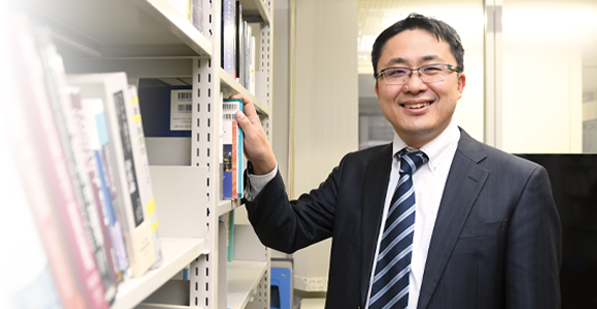Project Associate Professor/Pang-jo Chun
専門分野:情報社会基盤学,インフラ維持管理
Infrastructure informatics, Infrastructure maintenance, Infrastructure asset management
担当講義:i-Constructionシステム学特論
Special Lecture on i-Construction Systems for Infrastructure Projects
研究業績等(Researchmap):https://researchmap.jp/p_chun
2003年東京大学工学部土木工学科卒業,2004年 Yonsei Univeristy(交換留学),2005年東京大学大学院工学系研究科社会基盤学専攻修士課程修了,2010年Wayne State University博士課程修了(Ph.D.),2010年 Yonsei University Postdoctoral Research Associate, 2010年 愛媛大学大学院理工学研究科 助教,2016年同准教授,2019年より東京大学 大学院工学系研究科 特任准教授
Pang-jo Chun is currently a Project Associate Professor at the Department of Civil Engineering, The University of Tokyo. He received his PhD from Wayne State University in 2010 and subsequently worked at Yonsei University in Korea as a Project Research Associate until he moved to Ehime University in December of the same year. He worked there until March 2019, and since April 2019, he has been a Project Associate Professor with the Graduate School of Engineering, The University of Tokyo.
■ 研究テーマの概要と展望
近年、日本の橋梁やトンネルなどの土木インフラ構造物の老朽化に伴う損傷の増加が深刻な問題となっています。そこから生じる事故を防ぐためには、適切な維持管理を行う必要がありますが、例えば橋梁の総数は国内だけでも73万橋以上あり、膨大な労力・コストがかかってしまいます。そこで本研究室では、「AI」や「ICT技術」を活用し、インフラ維持管理を高度化するための研究を行っています。
例えばドローンや赤外線カメラで撮影した画像について、ディープラーニングを活用して損傷の位置を調べるようなアルゴリズムの開発を進めていますが、この手法はすでに鉄道会社のトンネルや電力会社のダムなどでの実用化が始まろうとしています。
私たちはまた、電磁気学を活用した新たな点検器具の開発も手掛けています。サビを落とさず、非接触で、かつ空気中・水中を問わず鋼材の残存性能を点検できるもので、崩落事故が発生した高知県四万十市の岩間大橋でも活用されました。このテーマは電磁気学の面からも革新的かつ一気通貫な研究であると認められ、2020年度イギリス土木技師学会(Institution of Civil Engineers; ICE)の論文賞「Telford Premium」を受賞しています。
このように、本研究室ではインフラ維持管理に「AI」や「ICT技術」を活用する研究を継続的に行いながら、今後は「点群データ」や「3次元モデル」のさらなる活用など、今までとは次元・概念の異なる維持管理手法の実現を目指して研究を進めています。
■ Overview of Research Topic and Future Outlook
In recent years, the increase in damage due to deterioration in civil engineering infrastructure, such as bridges and tunnels, in Japan has become a serious issue. Appropriate maintenance and management are necessary to prevent accidents caused by such damage. However, as an example, the total number of bridges in Japan is more than 730,000; hence, this would require a significant amount of labor and cost. Therefore, in our laboratory, we have been conducting research and development on the enhancement of infrastructure maintenance and management utilizing “AI” and “ICT.” For example, regarding images captured by drones or infrared technology, we have been developing an algorithm for investigating the location of damage by utilizing deep learning, and this method has already started being used on a practical level in railway company tunnels and electrical company dams. We have also developed a new type of inspection apparatus that utilizes electromagnetics. This apparatus allows us to inspect the residual performance of steel materials without removing rust, in a noncontact form, and in air and water. The apparatus was also utilized at the Iwama Ohashi Bridge in Shimanto City, Kochi Prefecture, where a collapse accident occurred. In the field of electromagnetics, this research topic has been recognized as being both innovative and comprehensive, and it duly won the “Telford Premium” Best Paper Award from the Institution of Civil Engineers in 2020. Hence, at our laboratory, we have been continually engaged in research on the utilization of “AI” and “ICT” in infrastructure maintenance and management and, moving forward, will continue to conduct studies on the additional use of “point cloud data” and “3D models” to realize maintenance management methods based on different dimensions and concepts from those of the past.
■ 研究室の目標とは?
土木構造物の建設時にはまた、作業者間のデータのやり取りが的確に進んでいないために生産性を落としているという課題があります。こうした課題の解決には、「データプラットフォームが大切だ」という認識は広まってきているものの、そもそも「データプラットフォームそのものがどうあるべきか」、「データの取得・蓄積・活用の枠組みがどうあるべきか」といった視点が欠かせません。このような研究開発を通して、「土木工学をワクワクするもの」にしながら、「安全性や生産性を大幅に上げていく」のが本研究室の目標です。
■ What is the purpose of the laboratory?
Another issue faced in constructing civil structures is the failure to make progress in exchanging data between workers, which reduces productivity. Although an increasing number of people are becoming aware of the importance of data platforms in resolving these issues, it is necessary to consider what the data platform itself should be as well as the required framework for data acquisition, storage, and utilization. The aim of the laboratory is to “greatly increase safety and productivity” through this type of R&D while making “civil engineering exciting.”
■ ゼミの特徴や魅力、学生とのコミュニケーション
新しいものや概念を作り上げていこうとするとき、あるいはそのようなことができる人材に成長しようとするとき、その人には自主性を発揮できる空間が必須だと考えています。その分、責任も伴いますが、こうした自主性の高さは当ゼミの特徴であり魅力と言えるでしょう。我々指導者も常にそうした教育を心掛けており、実際に本研究室では学生が自主性を持って自由闊達な議論をしながら、充実した時間を過ごしています。
学生とのコミュニケーションについて、普段は楽しく、ここぞというときは真面目に接しています。というのも、東京大学・東京大学大学院は、一方通行で教えるような場所ではありません。キャッチボールや壁当てのように、何かを投げたら返ってくるというやり取りを通した学びこそが重要です。そこで、楽しいときは楽しい会話から、重要な場面では真面目なやり取りから様々な発見をしてほしいと願っていますし、私もまた学生とのやり取りを通して学びまくりたいと思っています。
■ The characteristics and attractions of seminars and communication with students
When creating a new thing or concept or trying to develop resources who can do so, we feel that it is essential to provide a space where one can exercise their autonomy. This, of course, comes with a high degree of responsibility, and this high level of autonomy can be said to be a feature and point of appeal for this seminar. As instructors, our goal is to always try and educate our students, and the fact is that our students take the initiative and spend a great deal of time in our laboratory, discussing in a free and lively manner. We always try to communicate with our students in a fun manner; however, when the need arises, we also deal with them very seriously. Having said that, the University of Tokyo and the Graduate School of the University of Tokyo are not places where things are taught in just one way. It is important that learning should involve something being thrown and something coming back, such as playing catch or throwing a ball against a wall. Our wish is that they make a wide range of discoveries, have enjoyable conversations at fun times and serious conversations when things get serious, and that we can also learn through our interactions with our students.
■ 期待する学生像と本研究室での学び
「何か夢中になれるものを持っている」、あるいは「今は持っていなくても何かを見つけたら夢中になれそう」という学生に来てほしいです。その上で、土木が好きだったり、先端技術が好きだったりすると、私と話が合いそうですね。
これからこの道に進もうとする学生たちには、「物事の本質は何か?」と常に思いを馳せることを学んでほしい。多くの物事には「特有の面白さ」が存在しています。その面白さを自分なりに見つけ出し、夢中になれたら、人生はより楽しめるものとなるでしょう。ぜひ本研究室で、その何かを見つけ出してください。
■ What we expect of our students and their learning in our laboratory
We want students who think “I have something that I can become obsessed with” or “I don’t have anything now, but if I find it, I know I will be obsessed with it.” If they like civil engineering or cutting-edge technology, they will get on well with me. I hope that students who wish to take this path will learn to always ask themselves, “What is the true essence of things?” There is a “specific type of interest” existing in many things. If you can unearth that interest for yourself and become obsessed with it, your life will become more interesting and fun. We hope that you will be able to find that “something” at our laboratory.








